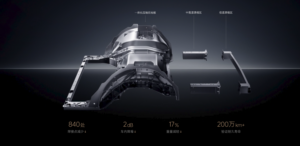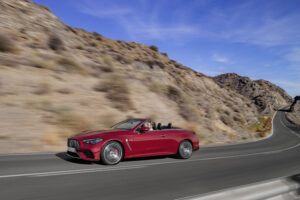
Follow us on social media:
Runtime: 9:49
0:00 U.S. Updates EV Tax Credit Rules, More EVs Eligible
0:56 UAW Ratifies New Contract with Daimler Truck
1:59 Chinese Cars Account For 1/3rd Of Global Sales
2:44 EVs Put Dent in Gasoline Demand
4:02 France Boosts EV Sales Targets
4:34 France Says It Will Welcome BYD
5:13 U.S. Provides $100 Million To Small Auto Suppliers
5:48 Xiaomi Tweaks Gigacasting Production Process
7:02 Mercedes-AMG Introduces New Convertible
Visit our sponsor to thank them for their support of Autoline Daily: Bridgestone, Intrepid Control Systems, Teijin Automotive and ZF.
This is Autoline Daily, the show dedicated to enthusiasts of the global automotive industry.
U.S. UPDATES EV TAX CREDIT RULES, MORE EVs ELIGIBLE
One of the things the panel brought up on last week’s Autoline After Hours is that there’s still a lot of confusion and misinformation around electric vehicles. In the U.S. one of the hardest parts to keep track of is EV tax incentives. Part of the problem is that the rules are always changing. And now it’s happening again. The Treasury Department and Internal Revenue Service are relaxing some of the requirements for sourcing battery materials. They’re now allowing automakers to use graphite, electrolyte salts, binders, and additives from Foreign Entity of Concern, like China and Russia. Automakers will have until 2027 to find another source of those materials, which is going to allow more EVs to remain eligible for tax credits in the U.S.
UAW RATIFIES NEW CONTRACT WITH DAIMLER TRUCK
The UAW scored another victory in contract negotiations. It ratified a new labor contract with Daimler Truck, only after coming to a tentative agreement late last month right before a strike was set to kick off. Nearly 95% of the 7,300 UAW workers voted in favor of the new contract, which is very similar to what workers at the Detroit Three got. It includes a 25% wage increase over the 4-year deal with an immediate 10% jump as well as profit sharing and cost of living adjustments. Even the lowest paid workers will see an $8 an hour raise, while some skilled trades workers will get a bump of more than $17 an hour. As you probably know, the UAW is also trying to organize the non-union car plants in the U.S. It already won at VW in Tennessee. Next up is Mercedes-Benz in Alabama. And stories like these should only help its efforts.
CHINESE CARS ACCOUNT FOR 1/3RD OF GLOBAL SALES
Even though there was only 1 Chinese automaker that cracked the Top 10 in global sales last month, Chinese cars accounted for 1 out of every 3 vehicles sold around the world. According to the China Passenger Car Association 8.15 million vehicles were sold globally last month and Chinese models made up 33% of those sales. Geely was the top Chinese automaker at #10 with a global market share of 3.5% in March. And then 4 of the next 7 automakers are Chinese, which helps explain why they account for so much volume. Overall, Toyota was the top automaker with over 10.5% market share in March.
EVs PUT DENT IN GASOLINE DEMAND
Speaking of sales, thanks to more EVs in China and the U.S., gasoline demand growth could be cut in half this year. According to energy analytics firm, Wood Mackenzie, gasoline demand is expected to rise 340,000 barrels per day this year compared to going up 700,000 per day last year, which is the lowest growth since 2020. China’s gas consumption is expected to grow just 1.3% this year or 2 million tons. Meanwhile, gas consumption in the U.S. is on the decline. Last year it fell to 376 million barrels per day, down from a peak of 392 million in 2018. What’s more, gasoline demand in the U.S. is expected to be flat this year. And the analysts say the reason for the slowdown in gas demand is due to growing EV sales in both the U.S. and China.
FRANCE BOOSTS EV SALES TARGETS
France is boosting its EV sales targets. The government formed a pact with automakers, suppliers and unions to sell 800,000 pure electric vehicles a year by 2027, which is a fourfold increase. The deal boosts the target for electric light commercial vehicle sales as well to 100,000 a year, which would be six times more. The agreement also aims to build up the EV supply chain in France, increase the number of charging stations and provide EV sales subsidies.
FRANCE SAYS IT WILL WELCOME BYD
And sticking with France for the moment. While the country has taken action to limit the sale of Chinese EVs in the country, France’s Finance Minister says it’s in favor of BYD opening a plant in the country and also added that “the Chinese auto industry is welcome in France.” Recently France passed a law to restrict subsidies for EVs produced with a high carbon footprint, a move that excludes many Chinese-made models. And while the EU doesn’t want Chinese made EVs shipped to the region, it’s ok with Chinese companies building assembly plants there because of the jobs they’ll bring.
U.S. PROVIDES $100 MILLION TO SMALL AUTO SUPPLIERS
The White House announced it’s providing $100 million to small and medium sized auto suppliers to help them in the transition to electric vehicles. Vice President Kamala Harris is visiting Detroit today to announce the funding. The money will go towards helping companies convert from manufacturing IC engine parts to EV components and to help diversify their business. Suppliers, especially the lower tiers, are under enormous financial pressure in the transition to EVs, so it’s good to see them get some relief to help with the switch.
XIAOMI TWEAKS GIGACASTING PRODUCTION PROCESS
Phone turned EV maker Xiaomi is copying Tesla’s large castings, but with a little tweak. It’s using an over 9,000-ton machine to make the rear casting of its SU7 electric sedan, which eliminates 72 other parts and pieces that would have been required to make the section. But Xiaomi also implemented a 3-stage anti-collision design. If one of the crush beams is damaged in a low-medium speed collision, they can be replaced, rather than possibly having to replace the whole casting. There’s been a lot of concern and confusion about having to replace entire castings in an accident. But it is possible to bend, straighten, weld and add reinforcement plates to these large castings. Another benefit of large castings is the ability to automate more of the assembly process. Xiaomi says it will have 700 robots in its factory. However, that will have an impact on its line speed. At full capacity, it says it will be able to make a car every 76 seconds, but that’s about double Tesla and even the legacies are around a minute.
MERCEDES-AMG INTRODUCES NEW CONVERTIBLE
Mercedes-AMG is adding a second convertible to its lineup. It already offers the AMG SL Roadster and now the AMG CLE 53 Cabriolet is joining the portfolio. It features a 48-volt mild hybrid system that’s combined with a 3.0L inline six-cylinder engine and a nine-speed automatic transmission that produces 443 horsepower and 413 lb-ft of torque, which is fed to all four wheels. The interior is highlighted by a 12.3-inch driver display and a 11.9-inch center infotainment system. The AMG CLE 53 convertible goes on sale in the U.S. in the second half of the year but pricing was not announced.
And that brings us to the end of today’s show. Thanks for making Autoline a part of your day.
Thanks to our partner for embedding Autoline Daily on its website: WardsAuto.com









The new Benz cabrio looks nice, but will be pricey, starting at $89,800 according to Edmunds. Of course, mandatory 4WD, at least in the U.S. market, like you really need that for what is, basically, a summer car.
Mercedes seems to be doing as BMW with transmissions for most of their performance cars, using torque converter units. They have a version without a torque converter that apparently has a wet clutch for breakaway, but works like a torque converter automatic with converter locked, once you are underway, but the car mentioned in the show uses the torque converter version.
I like the Benz. Convertibles and internal combustion engines are a good match. Even when they’re a mouthful to pronounce.
And after a number of years with V6es, they are now again using proper inline sixes.
In calculating the Chinese vehicles accounting for 1/3 of global sales, did that include all those tiny 2-seater inner city golf carts that have a top speed of 35mph? I have a feeling that may have skewed that stat. A more concerning number would be who exports the most vehicles?
If gas demand drops to levels similar to 2020 will that mean, we may have the same issues we had during Covid with getting refining factories back up and running?
Lambo, while they wouldn’t meet US safety standards, those “tiny 2-seater inner city golf carts that have a top speed of 35mph,” like BYD Seagull, are actually 4-seaters, and go 80 mph.
Here’s an interesting, though kind of long (20 minute) video about 20 of the cheaper Chinese EVs.
https://www.google.com/search?q=tiny+low+speed+chinese+cars&oq=tiny+low+speed+chinese+cars&gs_lcrp=EgZjaHJvbWUyBggAEEUYOTIHCAEQIRigATIHCAIQIRigATIHCAMQIRigATIHCAQQIRigAdIBCjE0NDc0ajBqMTWoAgiwAgE&sourceid=chrome&ie=UTF-8#fpstate=ive&vld=cid:9d434987,vid:m4GOzd3CwXA,st:0
Kit,
I have driven those Chinese vehicles. It is a terrifying experience above 30MPH. Definitely would not be a car for US interstates.
MERKUR,
I agree that a tiny car, or even a bigger car with a top speed of 80 mph would not be suitable for driving on the interstate, where half of the traffic is going 80 or more. They would be fine for driving on non-hilly two lane roads with a 55 mph speed limit, where average speeds are a little over 60.
As far as safety, they would be much safer than motorcycles, and I ride a motorcycle. I drive a small, but fairly fast Mini Cooper S on the interstate. I’ll be making an 1100 mile trip in the Mini in about two weeks.
The BYD Seagull is sold in some South American markets under the name Dolphin Mini.
Eventually they’ll have to relax, caveat, and twist the EV tax credit rules so far that even hybrids get them. Will be the only way to get anywhere near the sales numbers they crave for propaganda purposes.
I wonder if all those French EVs will burn safely during their constant riot outbreaks where thousands of cars regularly get set on fire? My understanding is that those batteries can be tough to put out with water!